
by Maureen | Jan 26, 2010 | Bergamo, Discoveries, Featured Articles, Incredible Locations, Journal, Photos
After rising up from the valley floor in the funiculare tram, a short walk brings you to the old plaza, la Piazza Vecchia. Encircled by palaces, a bell tower and a colonnaded portico, the space is punctuated at its center by a Baroque fountain from the late 1700s. The piazza is the heart of the city.Those palaces now house restaurants, hotels, a school and a museum.
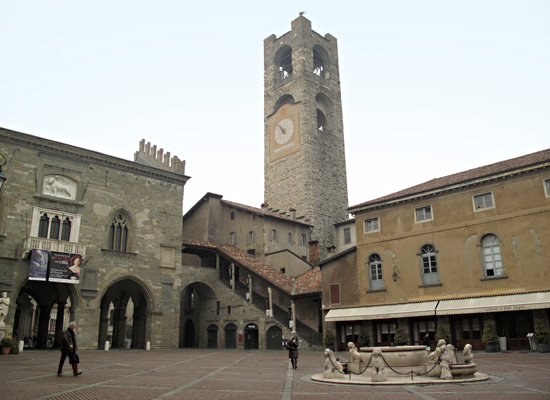
Passing through the portico (at the left in the photo above, under the banners) you find a white marble sundial that was set into the ground in 1798. It points the way north. (It seems to have been restored in 1982.)
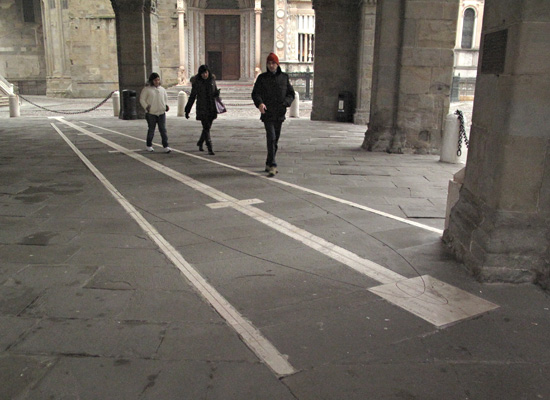
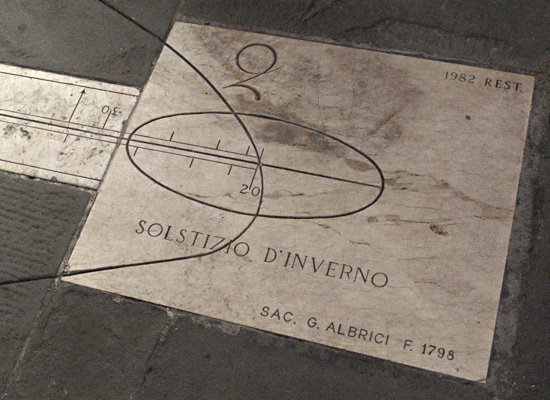
Just beyond the other side of the portico, you step into the Piazza del Duomo, the Plaza of the Cathedral. In mediaeval times this little square was at the political, commercial and religious heart of town. Facing south into the piazza, from your left to right is the Cattedrale di Bergamo (il Duomo), the Basilica di Santa Maria Maggiore, the Cappella Colleoni and the Battistero (Bapistry).
Cattedrale di Bergamo – il Duomo
The ceiling of the Duomo featured gilt patterning and accents to its carved decorations surrounding painted scenes.
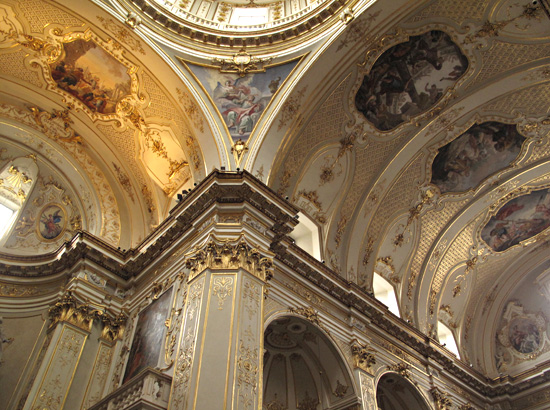
I have a real soft spot for the shrines to Mary. This Madonna della Pietá is in an elaborately carved and embellished side altar.
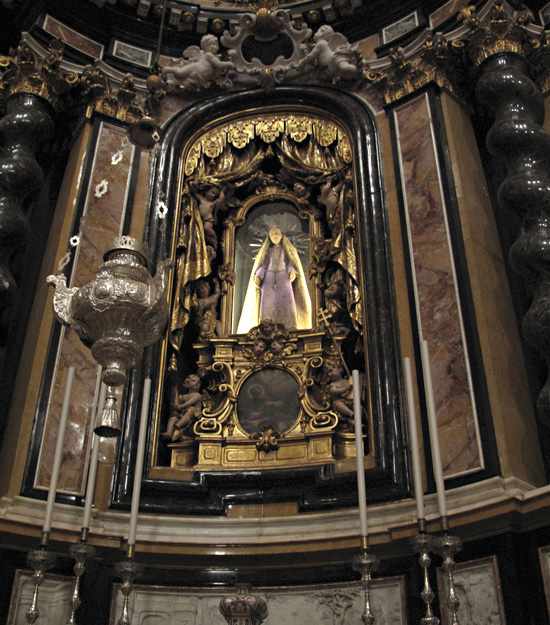
While in the cathedral, I heard chanting and thought perhaps they were playing a recording “for ambience”. No. I followed the singing which lead me down a staircase near the altar. I came to a very modern underground chapel and 50 Nuns at mass, surrounded by a dozen sarcophaghi.
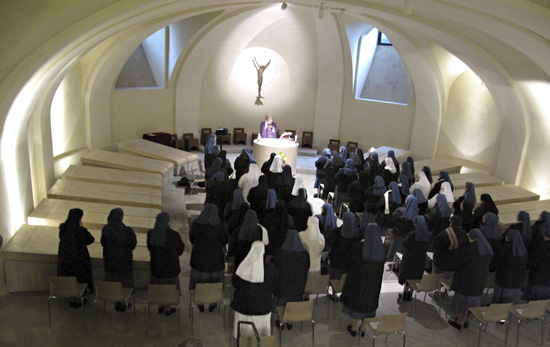
The dominant presence in the Piazza del Duomo is the union of entrances for the Basilica di Santa Maria Maggiore (at left in the photo below) and the Cappella Colleoni (at right).
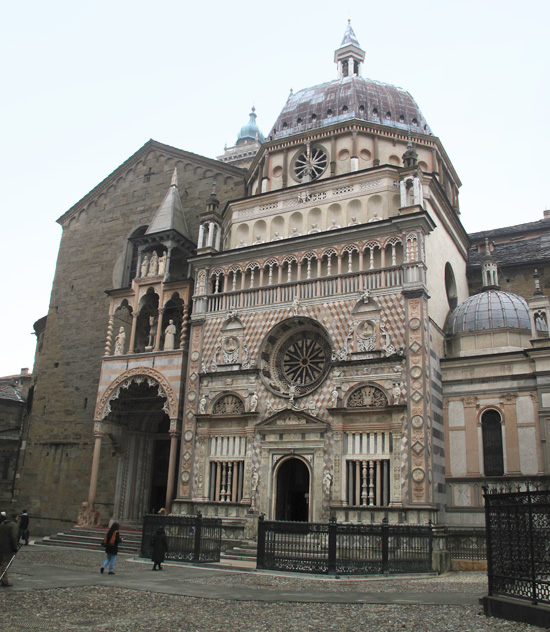
Basilica di Santa Maria Maggiore
The Basilica entry is fairly modest and overshadowed by the Chapel entry at its side. It opens, however, into a great, embellished space.
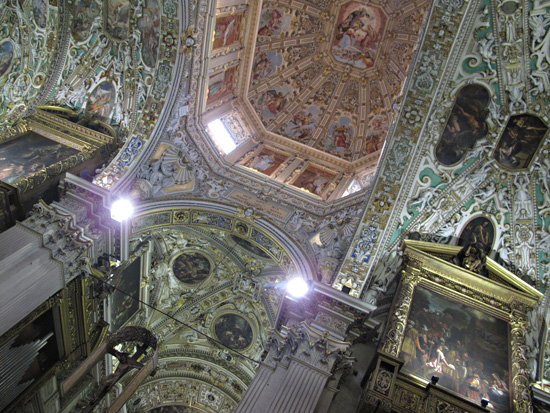
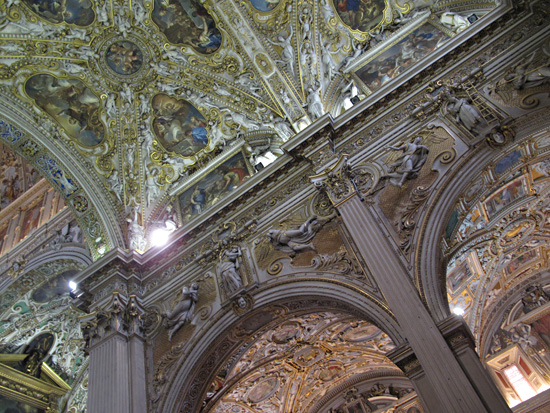
Here’s a shot of the crucifix that hangs over the central altar. (Note the skull and crossbones at the base of the cross.)
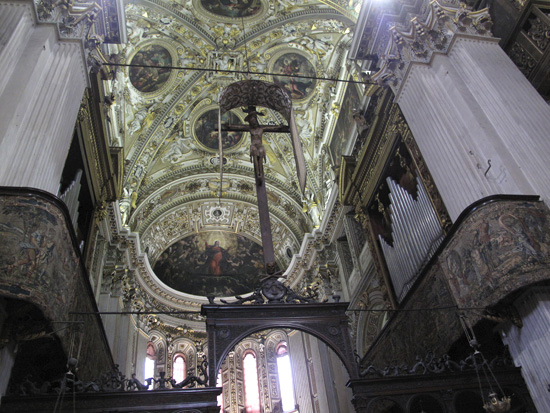
All vertical walls are covered with pictorial tapestries. (Although it was still very cold in there!)
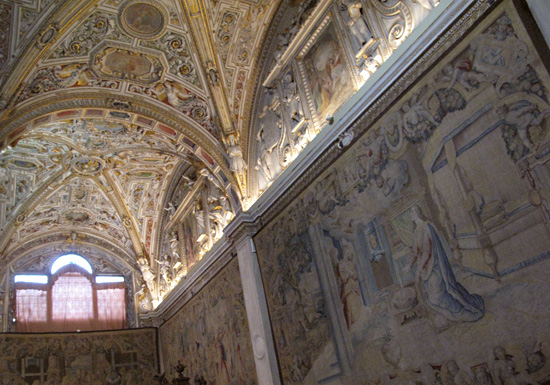
Here is historic Bergamo’s answer to today’s compact PDA/Calendar. This is how they note the times of the masses for week days and weekends.
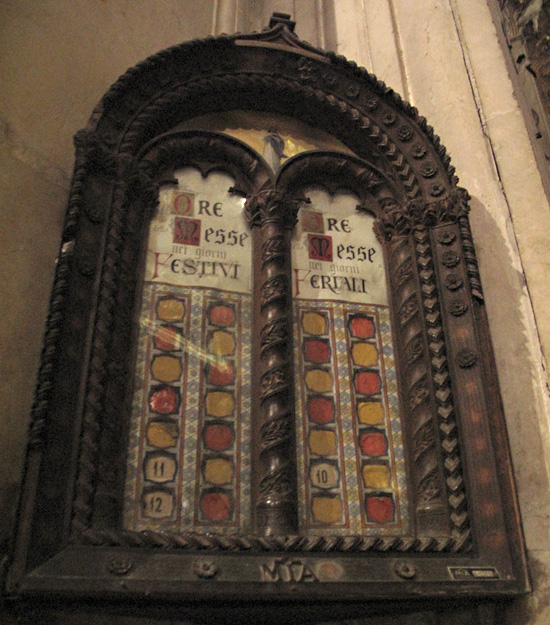
On the outside wall of the Basilica, just to the left of the front door, are permanently-mounted, flat bars of iron that are measuring devices from the Middle Ages. (I can’t find any information about their purpose or unit-of-measure.)
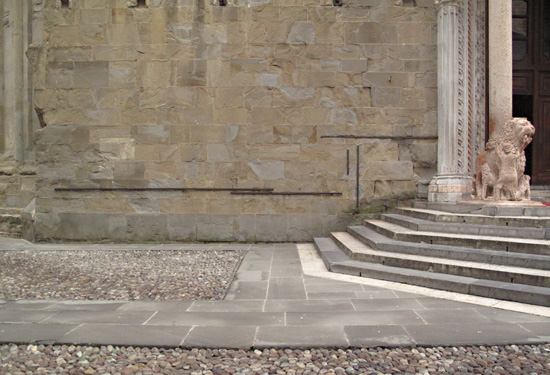
“The Weaver’s Wall” and “the Weaver’s Comb.” (?)


Cappella Colleoni
From a Wikipedia entry: “Dedicated to the saints Bartholomew, Mark and John the Baptist, it was built in 1472-1476 as the personal shrine for the famous condottiere Bartolomeo Colleoni, a member of one of the most outstanding families of the city, and his beloved daughter Medea. The site chosen was that of the sacristy of the nearby church of Santa Maria Maggiore, which was demolished by Colleoni’s soldiers.”
With its 3-D lozenge pattern, the repetition of columns, the figurative sculptures, rose windows, domes and bas-relief panels, no one and no building could compete for stature against this chapel. I think that one could study it all day, as well as the decorated fence surrounding the chapel entry. (No photos were allowed inside.)
The Baptistry
My favorite part of the Baptistry is the decorative ironwork fence around its octagonal shape/
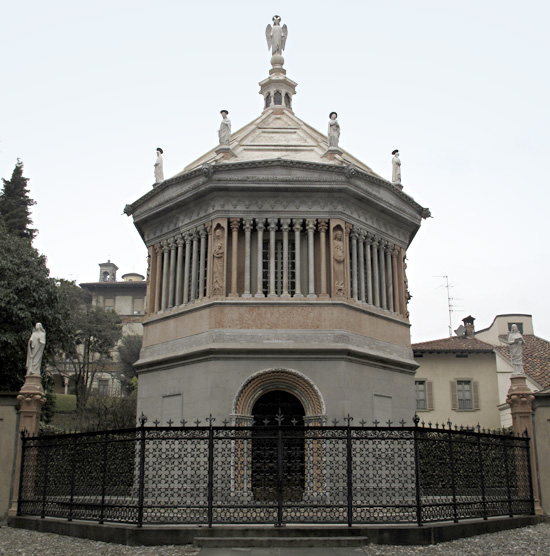
– – –
Note: So very many images and scholarly descriptions are available online that it would feel redundant if I tried to duplicate what’s already been said. I would rather toss out my own personal impressions and show what catches MY eye and mind, and provide enough information so that a blog reader could do their own further research.
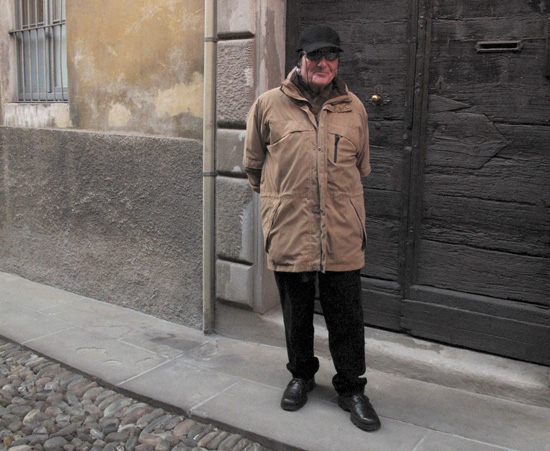
by Maureen | Jan 26, 2010 | Bergamo, Cheese, Discoveries, Featured Articles, Food!, Incredible Locations, Journal, Photos, Shopping & Markets
For 4 Euro and 20 cents – about $6.00 – each way, I was able to hop on the train and take a 45 minute ride to Bergamo, east-north-east of Milan.
Amazing amazingness. I’m still picking my chin up off the floor. I’m in awe that I can spend just a few dollars and in less than an hour be walking around in a walled city up on a hill, that was occupied by the Romans in the second century B.C.
They say that the name “Bergamo” has Celtic origins from the word “Bergheim”, “Home on the Mountain”. From what I read, the Celts inhabited the city and built the wall before the Romans took possession. And the story goes on from there.
I arrived at the train station in the “cittá bassa”, the lower city of Bergamo, then started walking in the direction of the upper city, the “cittá alta”. The two are quite separate and distinct from each other in appearance and identity. When I reached the lower “funiculare”, or tram station, I hopped on. I wanted to get UP.
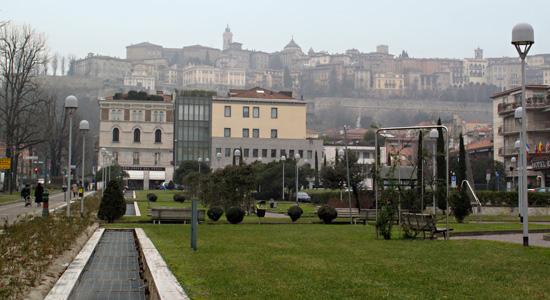
As I walked from the train station toward the “Cittá Alta” I caught this glimpse of the city above me.
By 11:00 in the morning I was walking on those roads made of upended, round cobbles. They’re actually quite uncomfortable to tread on, but they’ve also been designed with footpath-wide stripes of flat stone. How smart!
In these towns, it’s a thrill to wander the main route and browse the shop fronts, but also – even more so – to get away from main street and explore the back roads.
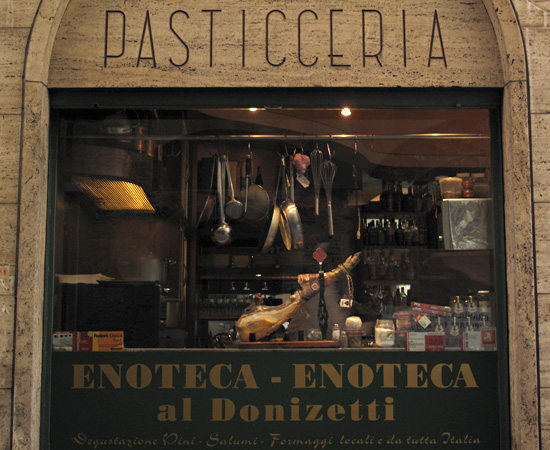
Would you ever see this in the U.S.? An animal’s leg, hoof-on, in the shop window? When a customer comes in, the store clerk steps over, carves away at the uncooked, aged hock, wraps up the meat and then goes on about the day.
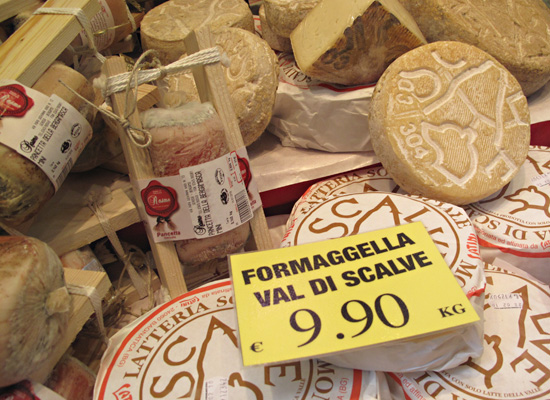
The imprinted cheeses are beautiful and I like the packaging on the (moldy) pancetta bound with wood.
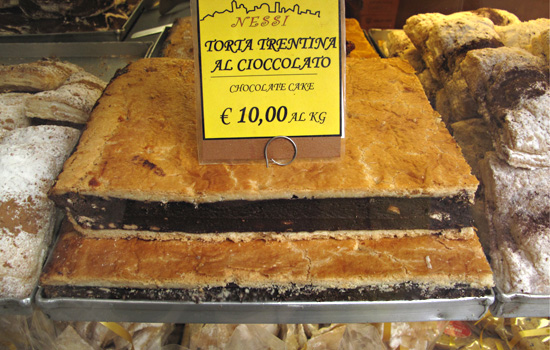
How could I NOT come back and buy some of this chocolate torte to bring home? It’s DENSE!
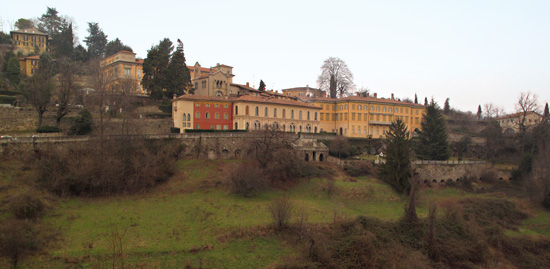
This is a view of the incredible places on the sweeping curve of the hillside, behind the wall.
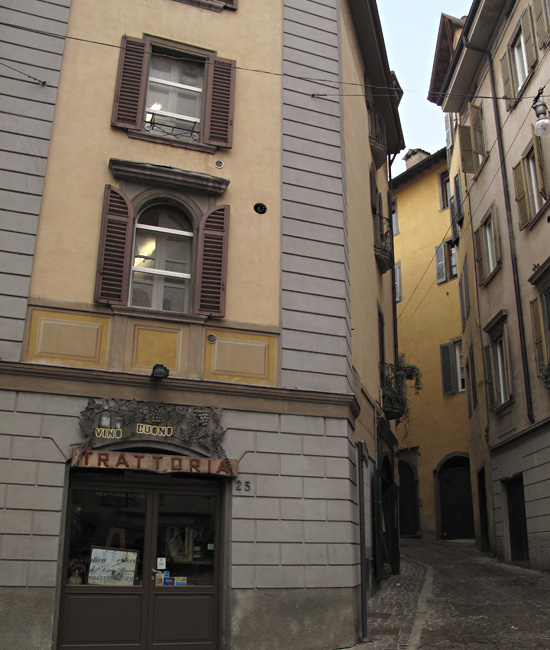
Towns like this beg to be explored, and the little “trattorie” beg to be sampled.
Bergamo reminds me of other places I’ve visited: San Gimignano, Siena, Venezia, Monteriggioni, Lucca, St. Angelo… There are hardly much more than footpaths in a rabbit warren fashion within the bounds of these cities. One car CAN fit on the streets of Bergamo, but just barely, and with difficulty if there’s also a pedestrian trying to get through. (Some of the cities I just listed don’t have any cars within them!) The narrow, shaded, no-end-in-sight passages generate such intrigue. What’s around the next bend?
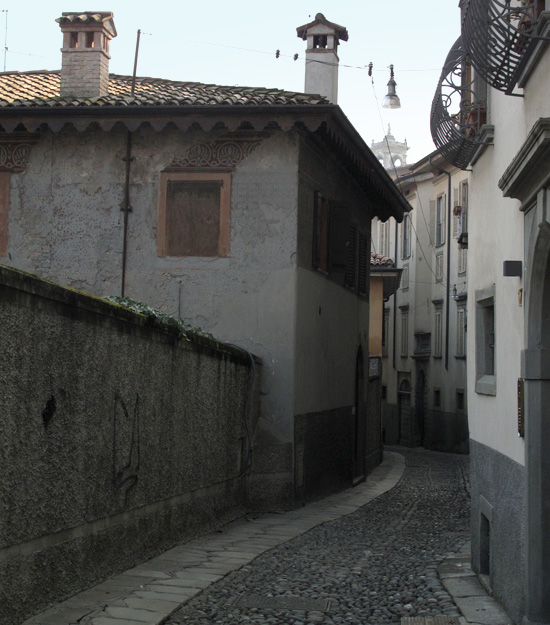
There’s fresco decoration just under the roofline of the house on the left. The round pebbles would provide good traction, but the flat stones at left are so much more comfortable to walk on.
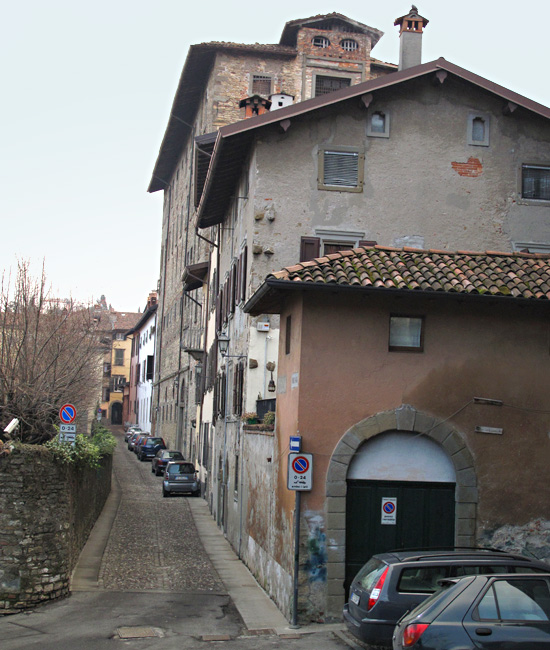
Park where you can. These homes look out over the valley below.
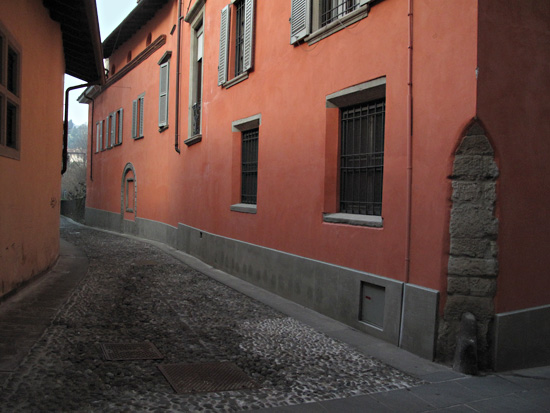
This is the side wall of the convent of the Domenican Nuns. I love their splash of color!
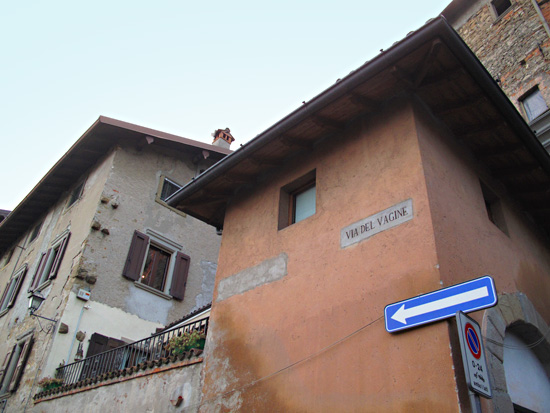
Why is the road leading to the convent called the “Way of the Vaginas”? (I’m sorry, but the question just had to be asked.)
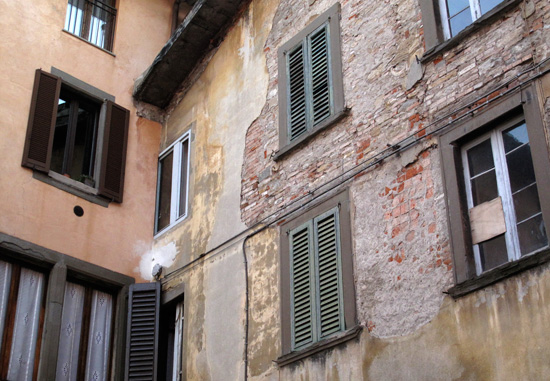
One of the things that so excites my mind is the layering of history in these towns, a result of demolition, restoration, remodeling, war destruction, weather, repair, embellishment.
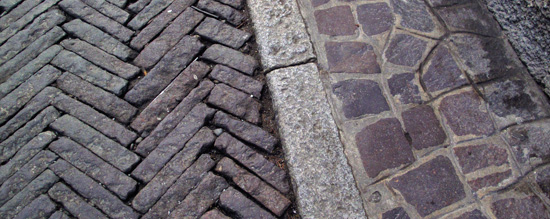
Left to right: street, curb and sidewalk.
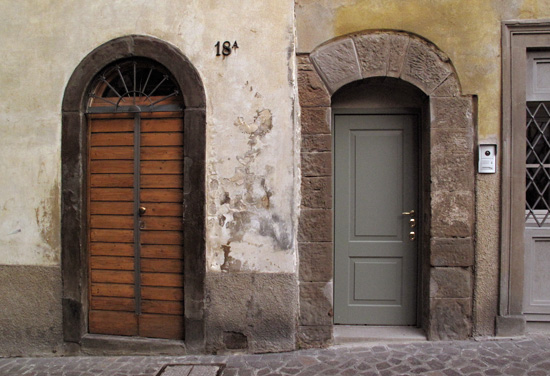
Some doors have fresh coats of paint. Some show the patina of wear, hand oils creating a sheen from use.
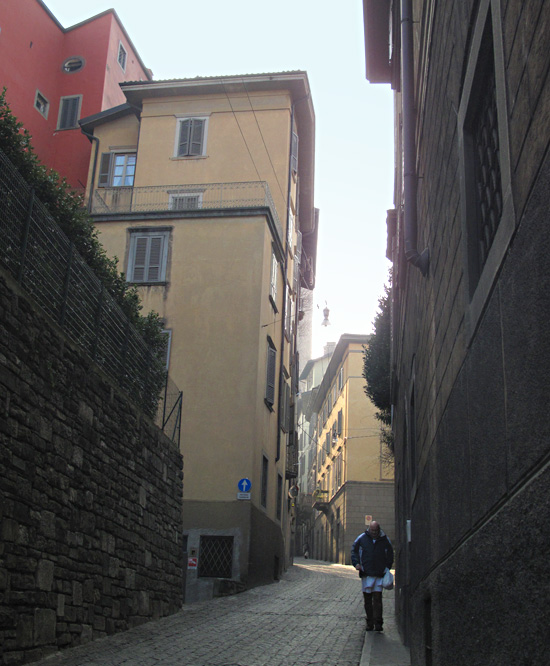
A walking town on a hillside. Ideal for one’s health.
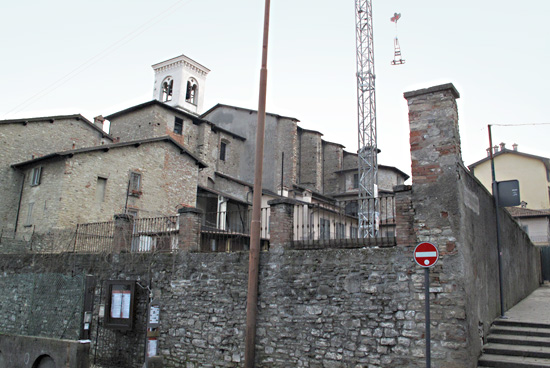
The construction crane is out of place with the old stone, but then again, it mimics the towers around it.
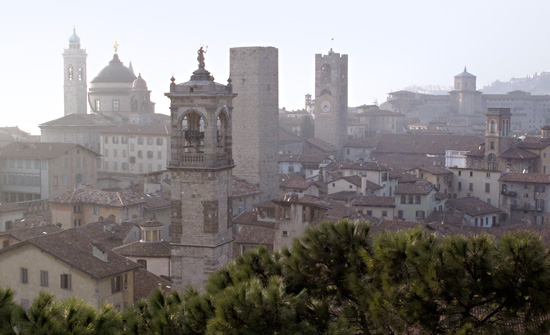
Late in the afternoon, I found my way to “La Rocca”, a tower, museum and military memorial. ALWAYS climb to the top of a tower in any city you visit!
At the end of the day, having explored the city and eaten a good meal, my camera battery was flashing red and I shot a few last images as the afternoon light waned. This door (below) caught my eye and demanded that I push the battery for just one more shot. When doing so, a man stopped to chat, saying that he, too, likes the old doors and is a sometime-painter. We talked about the longevity of wood versus stone and the absence of such ancient structures in the U.S. He asked where I’m from and when I told him I’m an American from Seattle, he said “But you speak such good Italian!” I smiled. We shook hands and wished each other well.

A painter that also loves the old doors.


































